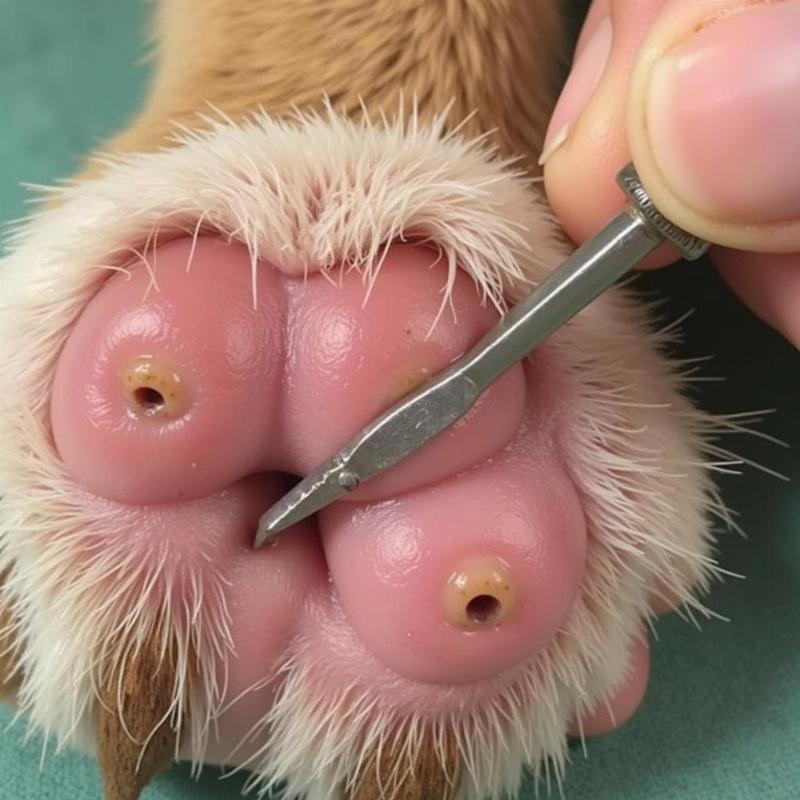Dealing with porcupine quills embedded in your dog’s face, paws, or body is a stressful experience for both you and your furry friend. Quick and proper removal is crucial to minimize discomfort and prevent further complications. This guide provides a step-by-step approach to safely remove porcupine quills and offers valuable insights into preventative measures.
Understanding the Urgency: Why Swift Quill Removal is Crucial
Porcupine quills are barbed, meaning they work their way deeper into tissue with every movement. Delayed removal can lead to infection, abscesses, migration of quills into internal organs, and significant pain for your dog. Acting quickly is paramount to your dog’s well-being.
Gathering Your Supplies: Essential Tools for Quill Removal
Before you begin, assemble the following items:
- Needle-nose pliers: These are essential for grasping and pulling out the quills.
- Sturdy gloves: Protect your hands from the quills and potential bacteria.
- Antiseptic wipes or solution: To clean the area after quill removal.
- Pain medication: Consult your vet for appropriate pain relief options.
- Muzzle (optional but recommended): A stressed dog may bite, even if normally gentle.
- Towel or blanket: To help restrain your dog if necessary.
Step-by-Step Guide to Removing Porcupine Quills
- Assess the situation: Determine the number and location of quills. If the quills are near sensitive areas like the eyes, mouth, or genitals, seek immediate veterinary care.
- Restrain your dog: Have a helper hold your dog or use a towel or blanket to restrain them gently but firmly. A muzzle can prevent bites from a frightened or painful dog.
- Cut the quills: If the quills are long, cut them in half with pliers to reduce their barb effect and prevent further embedding as they’re pulled. This also makes them easier to grasp.
- Pull quills straight out: Using pliers, grasp the quill firmly near the base, close to the skin. Pull straight out with a swift, decisive motion. Avoid twisting or bending, which can break the quill and leave fragments embedded.
- Disinfect the wound: After removing each quill, clean the area with antiseptic wipes or solution.
- Monitor for infection: Watch for signs of infection such as redness, swelling, pus, or increased pain. If you observe any of these, contact your veterinarian immediately.
When to Seek Veterinary Assistance: Recognizing Your Limits
While you can often remove quills at home, certain situations require professional veterinary care:
- Numerous quills: If your dog has a large number of embedded quills, especially in sensitive areas.
- Deeply embedded quills: If quills are broken off or difficult to grasp.
- Quills near sensitive areas: Eyes, mouth, throat, or genitals require expert removal.
- Signs of infection: Redness, swelling, pus, or increased pain indicate the need for veterinary attention.
- Difficulty restraining your dog: If your dog is too stressed or aggressive to handle safely.
Preventing Future Encounters: Minimizing the Risk
- Avoid porcupine habitats: Be mindful of known porcupine areas, especially during dawn and dusk when they are most active.
- Keep your dog on a leash: This provides better control and prevents them from roaming into hazardous areas.
- Train a strong recall: A reliable recall command can help you call your dog back before they encounter a porcupine.
- Carry a quill removal kit: Being prepared can make a significant difference in a quick and efficient removal process.
What to Do After Quill Removal: Post-Removal Care
After removing the quills, monitor your dog closely. Ensure they are eating and drinking normally, and watch for any signs of discomfort or infection. If your dog continues to show signs of pain or distress, consult your veterinarian.
 Dog Recovering After Quill Removal
Dog Recovering After Quill Removal
Frequently Asked Questions about Porcupine Quills
- Are porcupine quills poisonous? No, porcupine quills are not poisonous, but they can cause infection and other complications if not removed promptly.
- Can porcupine quills work their way out on their own? While some quills may eventually work their way out, relying on this can be risky and painful for your dog.
- How long does it take for a quill wound to heal? Healing time varies depending on the severity of the injury, but generally, it takes a few days to a couple of weeks.
- Can I use tweezers to remove porcupine quills? Tweezers are not recommended as they may break the quills, making removal more difficult.
- What kind of pain medication can I give my dog? Consult your veterinarian for appropriate pain relief options for your dog. Never give human medication to your dog without veterinary guidance.
- How can I tell if a quill wound is infected? Look for signs like redness, swelling, pus, increased pain, or a foul odor.
- What should I do if I can’t remove all the quills? Contact your veterinarian immediately for professional assistance.
Conclusion
Removing porcupine quills from your dog requires prompt action and the right approach. This guide equips you with the knowledge and steps needed to handle this challenging situation effectively. Remember, when in doubt, always consult your veterinarian. Your dog’s well-being is paramount, and timely intervention can prevent unnecessary suffering.
Beautdogs.us is your trusted source for comprehensive dog care information, breed insights, and product recommendations in the US. We provide valuable resources for both novice and experienced dog owners. For expert advice and personalized support, contact us at [email protected] or call us at +1 501-555-7529. Beautdogs.us is committed to helping you provide the best care for your beloved canine companion.